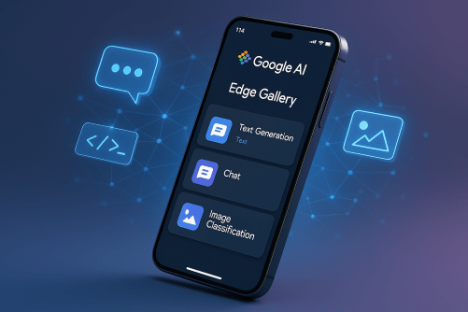Google has quietly revolutionized mobile AI with the launch of AI Edge Gallery, an experimental Android app that enables users to run powerful AI models directly on their smartphones without requiring an internet connection.
This groundbreaking development marks a significant shift toward privacy-first, on-device artificial intelligence that could transform how we interact with AI technology.
What is Google AI Edge Gallery?
Google AI Edge Gallery is an experimental Android application that allows users to download and run open-source AI models from Hugging Face locally on their devices. Unlike traditional cloud-based AI services that require constant internet connectivity and send data to remote servers, Edge Gallery processes everything on your smartphone, ensuring complete privacy and offline functionality.
The app represents Google’s commitment to democratizing AI technology while addressing growing privacy concerns about data handling in AI applications. By bringing powerful language models directly to mobile devices, Google is pioneering a new era of edge computing for artificial intelligence.
Key Features and Capabilities

Three Primary Interaction Modes
1. Conversational AI
- Multi-turn dialogue capabilities with AI assistants
- Context-aware conversations that maintain chat history
- Natural language processing for complex queries
- Perfect for extended discussions and brainstorming sessions
2. Image Understanding
- Upload photos and ask questions about visual content
- Advanced computer vision capabilities
- Object recognition and scene analysis
- Ideal for accessibility, education, and content creation
3. Prompt Lab
- Single-turn interactions for quick AI responses
- Text summarization and content analysis
- Code generation and programming assistance
- Content rewriting and creative writing support
Supported AI Models
Google AI Edge Gallery comes with access to several powerful AI models:
Google’s Gemma Series:
- Gemma 3 models (various parameter sizes)
- Gemma 3n models optimized for mobile devices
- Fine-tuned for different use cases and performance requirements
Alibaba’s Qwen 2.5 Series:
- Advanced language understanding capabilities
- Multilingual support and cultural awareness
- Optimized for diverse conversational scenarios
Model Size Options:
- Lightweight versions: ~500 MB (perfect for basic tasks)
- Comprehensive options: ~4 GB (advanced capabilities)
- Flexible sizing to match device storage and performance needs

System Requirements and Performance
Minimum Requirements
- Operating System: Android 10 or higher
- RAM: At least 6GB (8GB+ recommended)
- Processor: Modern chipset with sufficient computational power
- Storage: 1-5GB free space depending on chosen models
Performance Benchmarks
Google’s internal testing reveals impressive performance metrics:
- Time-To-First-Token (TTFT): 1.3 seconds on Pixel 8 Pro
- Model: 2B-parameter Gemma model
- Optimization: LiteRT runtime for hardware acceleration
- Multitasking: Simultaneous handling of multiple AI tasks
The app’s performance is optimized through Google’s LiteRT runtime, which ensures efficient inference across different Android hardware configurations. This technology enables smooth operation even on mid-range devices while maintaining responsive user experiences.
Privacy and Security Advantages
Complete Offline Operation
One of Edge Gallery’s most compelling features is its complete offline functionality. All AI processing occurs locally on your device, which means:
- Zero Data Transmission: No personal information sent to remote servers
- Complete Privacy Control: Users maintain full ownership of their data
- No Internet Dependency: Full functionality without network connectivity
- Enhanced Security: Reduced attack surface from external threats
Privacy-First Design
The offline-first approach addresses several critical privacy concerns:
- Sensitive conversations remain on your device
- Personal photos and documents aren’t uploaded to cloud services
- Corporate and professional data stays secure
- Compliance with data protection regulations becomes easier
Practical Use Cases and Benefits
Connectivity Independence
- Remote Areas: Access AI capabilities in locations with poor network coverage
- Travel Scenarios: Use AI features during flights or in foreign countries
- Cost Savings: Avoid expensive data charges when roaming
- Network Restrictions: Maintain functionality in environments with limited internet access
Professional Applications
- Content Creation: Draft articles, emails, and creative content offline
- Code Development: Generate and debug code without internet dependency
- Image Analysis: Analyze photos and documents for business purposes
- Research Support: Summarize texts and extract insights from documents
Educational Benefits
- Study Support: Get explanations and summaries of complex topics
- Language Learning: Practice conversations with AI tutors
- Homework Assistance: Generate ideas and check understanding
- Accessibility: Support for students with varying learning needs
Installation and Setup Guide
Current Availability
Google AI Edge Gallery is currently available as an experimental Alpha release through the Google AI Edge GitHub repository. The app operates under an Apache 2.0 license, making it freely accessible for both personal and commercial use.
Installation Steps
- Visit the GitHub Repository: Navigate to github.com/google-ai-edge/gallery
- Download the APK: Access the latest release from the releases section
- Enable Unknown Sources: Allow installation from unknown sources in Android settings
- Install the App: Follow standard Android installation procedures
- Download Models: Select and download your preferred AI models within the app
Initial Setup
- Choose models based on your device’s storage capacity
- Configure performance settings for optimal experience
- Test different interaction modes to understand capabilities
- Explore advanced features like custom model importing
Developer Features and Customization
Advanced Capabilities
Edge Gallery isn’t just for end users – it’s also a powerful tool for developers and researchers:
Custom Model Import:
- Import your own LiteRT-format models
- Test experimental AI configurations
- Prototype new AI applications
- Research on-device AI capabilities
Developer Resources:
- Comprehensive API documentation
- Sample code and implementation examples
- Community support through GitHub
- Regular updates and improvements
Technical Architecture
The app serves as a practical demonstration of Google’s LLM Inference API and showcases the potential of on-device generative AI. According to developer discussions on Reddit, the app functions primarily as “a sample app made to be a reference for devs who are building apps that use on device llms.”;
Future Development and Roadmap
Upcoming Features
Google has confirmed several developments in the pipeline:
iOS Version: An iOS version is currently in development and expected to be released soon, expanding the platform’s reach to Apple device users.
Enhanced Models: Continuous updates to available AI models with improved capabilities and performance optimizations.
Community Feedback Integration: Google is actively seeking feedback from the developer community to improve the experience and expand capabilities.
Long-term Vision
Edge Gallery represents Google’s broader strategy to:
- Democratize access to advanced AI technology
- Pioneer privacy-first AI solutions
- Reduce dependency on cloud infrastructure
- Enable AI functionality in low-connectivity environments
Comparison with Competitors
Advantages Over Cloud-Based AI
- Privacy: Complete data control vs. cloud storage concerns
- Speed: No network latency vs. internet-dependent response times
- Cost: No ongoing API costs vs. subscription or usage fees
- Reliability: Always available vs. dependent on service uptime
Market Positioning
Google’s Edge Gallery positions the company ahead of competitors in the on-device AI space, particularly compared to Apple’s Siri and other voice assistants that rely heavily on cloud processing. This move demonstrates Google’s commitment to edge computing and privacy-conscious AI development.
Getting Started: Best Practices

Optimal Usage Tips
- Start Small: Begin with lightweight models to understand capabilities
- Storage Management: Monitor device storage when downloading larger models
- Performance Testing: Test different models to find the best fit for your device
- Battery Optimization: Be aware of increased battery usage during intensive AI tasks
- Regular Updates: Keep the app updated for latest features and improvements
Common Use Cases to Explore
- Draft emails and messages without internet connectivity
- Analyze photos for content, accessibility, or organization
- Generate code snippets and programming solutions
- Summarize long documents and articles
- Practice conversations for language learning
Technical Considerations and Limitations
Current Limitations
- Alpha Status: Experimental release with potential bugs and incomplete features
- Device Requirements: Requires modern Android devices with sufficient RAM
- Model Selection: Limited to pre-configured models and custom imports
- Battery Impact: Intensive AI processing can drain battery faster
Performance Factors
- Device specifications significantly impact performance
- Model size affects both capability and resource usage
- Multitasking capability varies by device hardware
- Regular app updates may improve optimization
The Future of Mobile AI
Google AI Edge Gallery represents a fundamental shift in how we think about artificial intelligence on mobile devices. By bringing powerful AI capabilities directly to smartphones without requiring internet connectivity, Google is addressing three critical needs:
- Privacy Protection: Users maintain complete control over their data
- Universal Access: AI becomes available regardless of connectivity
- Performance: Eliminates network latency for responsive experiences
This development signals a broader industry trend toward edge computing and privacy-first AI solutions. As mobile devices become more powerful and AI models become more efficient, we can expect to see more applications following this on-device approach.
Conclusion
Google AI Edge Gallery marks a pivotal moment in mobile AI development, offering users unprecedented access to powerful artificial intelligence without compromising privacy or requiring constant internet connectivity. While currently in its experimental phase, the app demonstrates the immense potential of on-device AI processing and sets the stage for a new generation of privacy-conscious AI applications.
For developers, researchers, and privacy-conscious users, Edge Gallery provides an exciting glimpse into the future of mobile AI. As Google continues to refine the platform and expand its capabilities, we can expect to see significant improvements in performance, model selection, and user experience.
Whether you’re a developer looking to explore on-device AI capabilities, a professional seeking private AI assistance, or simply someone interested in cutting-edge technology, Google AI Edge Gallery offers a compelling introduction to the next generation of mobile artificial intelligence.
Ready to try Google AI Edge Gallery? Visit the official GitHub repository to download the app and start exploring the future of offline AI on your Android device.
Have you tried Google AI Edge Gallery?






